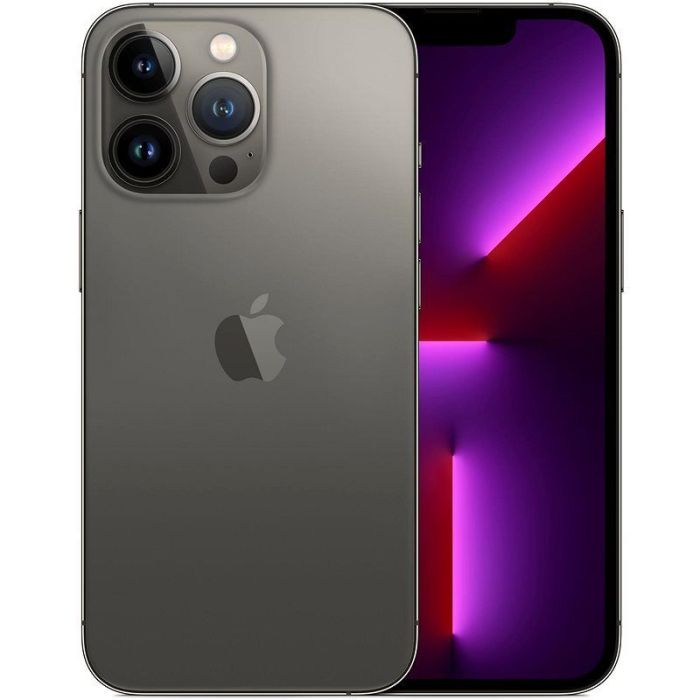TECHNICAL SPECIFICATIONS | |
| Brand | Apple |
Storage | 1TB |
Onboard RAM | 6GB |
Processor | A15 Bionic Chip (6 Cores) |
| iOS | iOS 15.0 |
| USB Support | Sync & Charge |
Firewire Support | None |
Connectivity | USB-C |
Ports | Lightning Only |
| Case Type | Handheld |
Form Factor | iPhone 13 Pro |
Housing Color | Metallic Glass |
Controller | Haptic Touch |
Display | 6.1" Super Retina XDR PM 2532x1170 (460 ppi) The iPhone 13 Pro has a 6.1" (diagonal) widescreen "Super Retina XDR with ProMotion" OLED screen. It specifically has a 2532x1170 native resolution at 460 ppi, adaptive refresh rates up to 120 Hz, a 2,000,000:1 typical contrast ratio, and 100 nits typical max brightness (1200 nits max brightness HDR). It supports True Tone capability, Wide color (P3), and "Haptic Touch." as well. It has a "Ceramic Shield" front for durability, too. |
Camera/Photos | 12.0 Megapixels |
| Camera/Videos | Apple reports that the iPhone 13 Pro supports "HEVC, H.264, MPEG-4 Part 2, and Motion JPEG." It also supports up to 4K HDR AirPlay for mirroring, photos and video out to the Apple TV 2nd Gen or later or AirPlay 2-enabled smart TV as well as video mirroring and video out "up to" 1080p through the Lightning Digital AV Adapter and the Lightning to VGA Adapter. |
| Audio Support | Apple reports that the iPhone 13 Pro supports "AAC LC, HE AAC, HE AAC v2, Protected AAC, MP3, Linear PCM, Apple Lossless, FLAC, Dolby Digital (AC 3), Dolby Digital Plus (E AC 3), Dolby Atmos, and Audible (formats 2, 3, 4, Audible Enhanced Audio, AAX, and AAX+)." |
| Cellular and Wireless | 802.11ax (2x2 MIMO) Bluetooth 5.0 Apple notes that the iPhone 13 Pro supports 802.11ax Wi-Fi 6 with 2x2 MIMO as well as 5G, Gigabit-class LTE with 4x4 MIMO and LAA, Bluetooth 5.0, Ultra Wideband "for spatial awareness," NFC with reader mode, and Express Cards with power reserve (for transit systems). |
| Sim Support | Dual SIMs (one hardware nano SIM and one software-based eSIM or dual eSIMs) |
| Chip | A15 Bionic Chip |
| Dimension | 146.7 x 71.5 x 7.65 mm |
| Weight | 204 g |
All iPhone 13 Pro models have a haptic-touch capable 6.1" (diagonal) "Super Retina XDR display with ProMotion" (2532x1170, 460 ppi, 120Hz refresh rates) that occupies nearly the entire front of the device. It has four cameras. On the front -- tucked in the "notch" -- is a "TrueDepth" camera that in addition to supporting "Advanced Face ID" identification functionality, takes 12-megapixel photos, shoots 4K video, and has software support for Portrait mode, Portrait Lighting, and more. The rear packs a 4K video-capable "pro 12 megapixel camera system" with three cameras -- Telephoto, Wide, and Ultra Wide. The Telephoto has a f/2.8 aperture, the Wide has a f/1.5 aperture, and the Ultra Wide has a f/1.8 aperture and a 120-degree field of view. iPhone 13 Pro hosts larger and better sensors that promise reduced noise, faster shutter speeds, better detail, improved low-light photography, and macro support for the first time. It also supports "Sensor-shift OIS" for improved shot stabilization. These cameras additionally provide a new "Cinematic mode" with a simulated depth effect (1080p, 30 fps) and new "ProRes" codec compatibility (1080p at 30 fps on the 128 GB configuration and 4K at 30 fps on higher capacity configurations).
The iPhone 13 Pro uses a partially "surgical grade" stainless steel case with flat polished stainless steel sides and has a glass front and back. The iPhone 13 Pro uses a stainless steel case with flat sides and has a glass front and back. The front has a "Ceramic Shield" cover for durability and the back has an integrated "MagSafe" magnetic charging connection. It is splash, water, and dust-resistant to the IP68 standard (maximum depth of 6 meters up to 30 minutes). It has four color options -- graphite (dark gray), gold, silver, and "Sierra Blue.".
Internally, the iPhone 13 Pro is powered by a 64-bit 3.0 GHz "Apple A15 Bionic" processor with six cores -- two performance cores and four high-efficiency cores -- and a 16-core Neural Engine. It has 6 GB of RAM and 128 GB, 256 GB, 512 GB or 1TB of flash storage. It also supports 802.11ax Wi-Fi 6 with 2x2 MIMO, 5G wireless, Bluetooth 5.0, Ultra-Wideband "for spatial awareness," NFC for Apple Pay, "Express Cards with power reserve" for compatible transit systems, and support for Dual SIM (one hardware nano SIM and one software-based eSIM or dual eSIMs).
The iPhone 13 Pro models have four rear cameras and a single front camera. The rear has a "pro" 12 megapixel "camera system" with Telephoto, Wide, and Ultra Wide cameras. The Telephoto has a f/2.8 aperture, the Wide has a f/1.5 aperture, and the Ultra Wide has a f/1.8 aperture and a 120-degree field of view. The rear camera system supports a simulated 3x optical zoom in, 2x optical zoom out, a 6x optical zoom range, and digital zoom up to 15x. It also supports 4K video recording at 24, 25, 30, or 60 fps as well as 1080p HD video at 25, 30, or 60 fps and 720p HD video at 30 fps. Compared to earlier cameras, it hosts larger and better sensors that promise reduced noise, faster shutter speeds, better detail, improved low-light photography, and macro support for the first time. It also supports "Sensor-shift OIS" for improved shot stabilization. These cameras additionally offer a new "Cinematic mode" with a simulated depth effect (1080p, 30 fps) and new "ProRes" codec compatibility (1080p at 30 fps on the 128 GB configuration and 4K at 30 fps on higher capacity configurations).
The front "TrueDepth" camera is 12 megapixels, has a f/2.2 aperture, and supports 4K video recording at 24, 25, 30, or 60 fps and 1080p HD video recording at 25, 30, or 60 fps.
| Screen Size | 6.1-inch |
|---|---|
| Processor Frequency | 3GHz to 4GHz |
| Internal Memory (RAM) | 6GB |
| Storage Capacity | 1TB |
| Cellular Support | No |
| Built-in Flash | Yes |
| Built in Microphone | Yes |
| Built in Speakers | Yes |
| Display Resolution | 2532x1170 Pixels |
| Front Camera Megapixel | 12MP |
| Rear Camera Megapixel | Triple 12MP |
| 3G | No |
| 4G | No |
| 5G | Yes |
| Bluetooth | Yes |
| Wi-Fi | Yes |
| Refurbished | Yes |
| Condition | Grade A |
| Network | Unlocked |
| Generation | 14th Generation |





